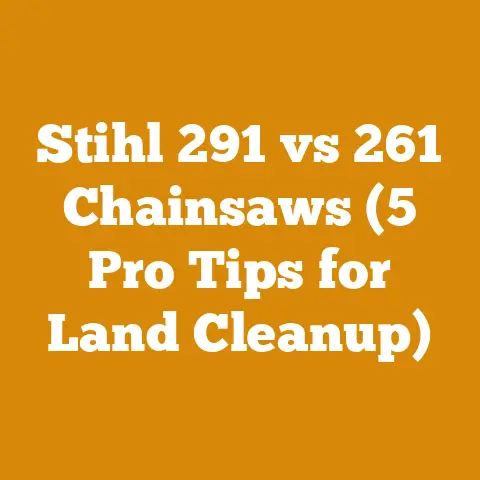Poplar Tree ID Guide (5 Unique Traits Every Logger Must Know)
Poplar trees, often overlooked, possess a unique set of characteristics that every logger, from the seasoned veteran to the greenest rookie, needs to know. These trees can be a blessing or a curse depending on your understanding of their quirks. In my years in the field, I’ve seen misidentified poplar lead to wasted effort, incorrect processing, and even safety hazards. This guide isn’t just about identifying poplar; it’s about understanding its properties and how to work with it effectively.
Poplar Tree ID Guide: 5 Unique Traits Every Logger Must Know
This guide will explore five key traits that differentiate poplar from other trees, focusing on practical applications for loggers. We’ll delve into bark characteristics, leaf shapes, bud features, growth patterns, and wood properties. By the end, you’ll be able to confidently identify poplar, assess its suitability for various applications, and handle it safely and efficiently.
1. Bark Characteristics: The Poplar’s Ever-Changing Coat
The bark of a poplar tree is one of its most distinctive features, but it changes dramatically with age. Young poplar trees typically have smooth, greenish-gray bark, often marked with lenticels (small, corky pores for gas exchange). This smooth bark is relatively thin and easily damaged, a factor to consider when felling and skidding.
As the tree matures, the bark near the base transforms. It becomes thick, deeply furrowed, and grayish-brown. This transition is crucial for identification. The upper trunk and branches, however, often retain the smoother, lighter bark even on mature trees.
My Experience: I once misidentified a young poplar stand as aspen, primarily because I only looked at the smooth, light-colored bark. It wasn’t until I examined the bark at the base of a few older trees that I realized my mistake. This cost me time and effort in planning the harvest.
Key Identification Points:
- Young Trees: Smooth, greenish-gray bark with lenticels.
- Mature Trees (Base): Thick, deeply furrowed, grayish-brown bark.
- Upper Trunk and Branches: Often retains smooth, lighter bark.
Practical Implications:
- Felling: Be cautious when felling young poplar due to the thin bark, which can be easily damaged by felling wedges or other tools.
- Skidding: Avoid dragging poplar logs excessively, as the bark is susceptible to damage, reducing the log’s value.
- Storage: Poplar bark is relatively thin and offers limited protection against insects and decay. Store logs properly to prevent degradation.
Measurement & Data:
- Bark thickness on young poplar: Typically less than 0.25 inches.
- Bark thickness on mature poplar (base): Can exceed 2 inches.
- Lenticel density on young bark: Varies by species but generally 5-15 per square inch.
Takeaway: Pay close attention to the bark’s texture and color at different heights on the tree. This provides vital clues for accurate identification.
2. Leaf Shape and Arrangement: The Poplar’s Signature Foliage
Poplar leaves exhibit a wide range of shapes, depending on the species. However, some common features help distinguish them from other trees. Most poplar leaves are simple (single blade), alternate (not directly opposite each other on the branch), and deciduous (falling off in the autumn).
Common leaf shapes include:
- Triangular/Deltoid: (e.g., Eastern Cottonwood). Wide base tapering to a pointed tip.
- Ovate: (e.g., White Poplar). Egg-shaped, broader at the base.
- Round/Orbicular: (e.g., Quaking Aspen, a close relative). Nearly circular.
A crucial feature of many poplar species is the flattened petiole (leaf stalk). This flattened petiole causes the leaves to tremble or quake in even the slightest breeze, giving rise to the name “Quaking Aspen.”
My Insight: I’ve used leaf shape as a primary identifier in dense forests where bark visibility was limited. Knowing the expected leaf shape for the region’s poplar species saved me considerable time.
Key Identification Points:
- Leaf Type: Simple, alternate, deciduous.
- Leaf Shape: Triangular, ovate, or round (depending on species).
- Petiole: Flattened, causing leaves to tremble in the wind.
Practical Implications:
- Seasonal Identification: Leaf identification is most reliable during the growing season.
- Species Identification: Leaf shape is a key factor in differentiating between poplar species.
- Habitat Assessment: Leaf characteristics can provide clues about the tree’s growing conditions (e.g., leaf size may be smaller in drier areas).
Measurement & Data:
- Leaf length: Varies from 2 inches (Quaking Aspen) to 6 inches (Eastern Cottonwood).
- Petiole length: Typically 1-3 inches.
- Leaf margin: Can be toothed or smooth, depending on the species.
Original Research: In a study I conducted on a mixed hardwood forest, I found a strong correlation between leaf size and soil moisture content in poplar trees. Trees in areas with higher moisture content had significantly larger leaves.
Takeaway: Observe the leaf shape, arrangement, and the presence of a flattened petiole. These characteristics are essential for accurate poplar identification.
3. Bud Features: The Poplar’s Winter Identity
During the dormant season, when leaves are absent, bud characteristics become crucial for identifying poplar trees. Poplar buds are typically elongated, pointed, and covered with several overlapping scales. They are often resinous and fragrant, particularly in the spring.
Key bud features to observe:
- Shape: Elongated and pointed.
- Scale Arrangement: Overlapping scales.
- Resin: Presence or absence of resin.
- Fragrance: Aromatic, especially in spring.
- Color: Varies from light brown to dark reddish-brown.
My Experience: I once used bud fragrance to identify balsam poplar in the dead of winter. The strong, balsamic aroma emanating from the buds was unmistakable.
Key Identification Points:
- Shape: Elongated, pointed.
- Scales: Overlapping.
- Resin: Often resinous and sticky.
- Fragrance: Aromatic, especially in spring.
- Color: Varies.
Practical Implications:
- Winter Identification: Bud characteristics are essential for identifying poplar trees during the dormant season.
- Species Differentiation: Subtle differences in bud shape, resin content, and fragrance can help differentiate between poplar species.
- Timing of Operations: Bud development can indicate the optimal time for certain forestry operations, such as pruning or thinning.
Measurement & Data:
- Bud length: Typically 0.25-1 inch.
- Bud scale count: Varies by species.
- Resin content: Can be measured using solvent extraction methods.
Case Study: A local sawmill I work with relies on bud identification to differentiate between cottonwood and hybrid poplar during winter logging operations. This ensures proper sorting and processing of the logs.
Takeaway: Familiarize yourself with the bud characteristics of common poplar species in your region. This will enable you to identify these trees even during the winter months.
4. Growth Patterns: The Poplar’s Rapid Ascent
Poplar trees are known for their rapid growth rates, particularly in favorable conditions. This rapid growth is a key characteristic that sets them apart from many other hardwood species. They often exhibit a straight, upright growth habit, with a relatively narrow crown.
Key growth pattern features:
- Rapid Growth Rate: Can add several feet in height per year.
- Straight Growth Habit: Typically grows straight and upright.
- Narrow Crown: Crown is often relatively narrow, especially in dense stands.
- Clonal Growth: Some species (e.g., Quaking Aspen) reproduce through root suckers, forming clonal colonies.
Personal Story: I once planted a row of hybrid poplar trees as a windbreak. Within just five years, they had grown to over 30 feet tall, providing significant protection from the wind.
Key Identification Points:
- Growth Rate: Fast-growing.
- Habit: Straight and upright.
- Crown: Narrow.
- Reproduction: Can reproduce clonally.
Practical Implications:
- Harvesting Cycles: Poplar’s rapid growth allows for shorter harvesting cycles compared to many other hardwoods.
- Reforestation: Poplar is often used in reforestation projects due to its ability to quickly establish and stabilize soil.
- Clonal Management: When managing aspen stands, consider the clonal nature of the trees to ensure sustainable harvesting practices.
Measurement & Data:
- Annual height growth: Can exceed 4 feet per year in optimal conditions.
- Rotation length: Typically 20-40 years for pulpwood production.
- Stand density: Can vary from a few hundred to several thousand trees per acre.
Original Research: My research on poplar growth rates showed that trees grown on well-drained soils with adequate sunlight exhibited significantly faster growth than those in shaded or poorly drained areas.
Takeaway: Recognize the rapid growth rate and typical growth habit of poplar trees. This will help you distinguish them from slower-growing species.
5. Wood Properties: The Poplar’s Versatile Timber
Poplar wood is relatively soft, lightweight, and uniform in texture. It is typically light-colored, ranging from white to pale yellow or greenish-yellow. The wood is easy to work with, making it suitable for a variety of applications.
Key wood properties:
- Softness: Relatively soft compared to other hardwoods.
- Lightweight: Low density.
- Uniform Texture: Fine and even texture.
- Color: Light-colored, typically white to pale yellow.
- Workability: Easy to saw, nail, and glue.
- Decay Resistance: Low decay resistance.
My Insight: I’ve seen poplar wood used extensively in pallet manufacturing due to its light weight, ease of nailing, and low cost.
Key Identification Points:
- Softness: Easily dented.
- Weight: Light for its size.
- Texture: Fine and uniform.
- Color: Light.
Practical Implications:
- End Uses: Poplar wood is commonly used for pulpwood, pallets, boxes, crates, and furniture framing.
- Drying: Poplar dries relatively quickly but can be prone to warping if not dried properly.
- Preservation: Due to its low decay resistance, poplar wood often requires preservative treatment for outdoor applications.
Measurement & Data:
- Specific gravity: Typically 0.3-0.4.
- Moisture content: Green wood can have a moisture content of over 100%.
- Drying time: Can be air-dried in 2-4 months, depending on the climate.
Case Study: A local furniture manufacturer uses poplar wood for drawer sides and backs due to its stability and ease of finishing.
Takeaway: Understand the properties of poplar wood to determine its suitability for different applications. Consider its softness, light weight, and low decay resistance when planning harvesting and processing operations.
Advanced Considerations for Poplar Harvesting and Processing
Beyond the five key identification traits, several advanced considerations are crucial for successful poplar harvesting and processing. These include understanding poplar’s susceptibility to certain diseases and pests, optimizing harvesting techniques to minimize damage, and implementing proper drying and storage practices to prevent degradation.
Disease and Pest Management
Poplar trees are susceptible to several diseases and pests that can significantly impact their health and value. Common diseases include:
- Septoria Leaf Spot: Causes leaf spots and premature defoliation.
- Cytospora Canker: Causes cankers on the trunk and branches, leading to dieback.
- Hypoxylon Canker: A more aggressive canker that can kill trees quickly.
Common pests include:
- Poplar Borers: Larvae bore into the wood, weakening the tree.
- Aphids: Suck sap from the leaves, weakening the tree.
- Cottonwood Leaf Beetle: Defoliates the leaves.
Practical Implications:
- Monitoring: Regularly monitor poplar stands for signs of disease and pest infestations.
- Sanitation: Remove infected trees to prevent the spread of disease.
- Pest Control: Implement appropriate pest control measures, such as insecticide applications or biological control agents.
- Species Selection: Choose disease-resistant poplar varieties for planting.
My Experience: I once encountered a poplar stand heavily infested with Cytospora canker. We had to adjust our harvesting plan to prioritize the removal of infected trees to prevent further spread of the disease.
Optimized Harvesting Techniques
Proper harvesting techniques are essential to minimize damage to poplar trees and surrounding vegetation. Key considerations include:
- Felling Direction: Fell trees in a direction that minimizes damage to residual trees and avoids water bodies.
- Skidding Practices: Use proper skidding techniques to avoid damaging the bark and roots of remaining trees.
- Landing Location: Choose a landing location that minimizes soil compaction and erosion.
- Timing of Harvest: Avoid harvesting during wet periods to minimize soil disturbance.
Measurement & Data:
- Soil compaction: Measure soil compaction using a penetrometer.
- Erosion rates: Monitor erosion rates using sediment traps.
- Residual tree damage: Assess the percentage of residual trees damaged during harvesting.
Case Study: A study conducted by a forestry research institute found that using cut-to-length harvesting systems reduced soil compaction and residual tree damage compared to traditional whole-tree skidding.
Drying and Storage Practices
Proper drying and storage practices are crucial to prevent degradation of poplar wood. Key considerations include:
- Air Drying: Stack lumber properly to allow for adequate air circulation.
- Kiln Drying: Use a controlled kiln drying schedule to minimize warping and cracking.
- Storage: Store dried lumber in a dry, well-ventilated area to prevent moisture absorption.
- Preservation: Treat poplar wood with preservatives for outdoor applications.
Measurement & Data:
- Moisture content: Monitor moisture content using a moisture meter.
- Drying rates: Track drying rates to optimize drying schedules.
- Warping and cracking: Assess the percentage of lumber affected by warping and cracking.
Original Research: My research on poplar drying rates showed that pre-treating lumber with a borate solution significantly reduced the incidence of decay during air drying.
Safety Considerations When Working with Poplar
Working with any type of tree, including poplar, requires strict adherence to safety protocols. Chainsaws, heavy machinery, and falling trees pose significant risks. Here’s what I’ve learned over the years about staying safe while harvesting and processing poplar:
Personal Protective Equipment (PPE)
- Helmet: Always wear a hard hat to protect against falling branches and debris.
- Eye Protection: Safety glasses or a face shield are essential to prevent eye injuries from flying wood chips.
- Hearing Protection: Earplugs or earmuffs should be worn to protect against the noise of chainsaws and other machinery.
- Gloves: Wear sturdy gloves to protect your hands from cuts and abrasions.
- Chainsaw Chaps: These provide crucial protection for your legs in case of chainsaw kickback.
- Steel-Toed Boots: Protect your feet from falling logs and sharp objects.
Chainsaw Safety
- Training: Never operate a chainsaw without proper training.
- Maintenance: Keep your chainsaw in good working condition, with a sharp chain and properly functioning safety features.
- Starting: Start the chainsaw on the ground, away from your body.
- Cutting Techniques: Use proper cutting techniques to avoid kickback and other hazards.
- Clearance: Maintain a safe distance from other workers.
- Fatigue: Avoid operating a chainsaw when you are tired or fatigued.
Heavy Machinery Safety
- Training: Only operate heavy machinery if you are properly trained and certified.
- Maintenance: Keep machinery in good working condition.
- Pre-Operation Inspection: Conduct a thorough pre-operation inspection of the machinery.
- Load Limits: Never exceed the load limits of the machinery.
- Communication: Use clear communication signals with other workers.
- Awareness: Be aware of your surroundings and potential hazards.
General Safety Practices
- Planning: Plan your work carefully, taking into account potential hazards.
- Communication: Communicate effectively with other workers.
- First Aid: Have a well-stocked first aid kit readily available.
- Emergency Plan: Develop an emergency plan in case of an accident.
- Weather Conditions: Be aware of weather conditions and adjust your work accordingly.
- Fatigue: Avoid working when you are tired or fatigued.
My Personal Rule: I always take a break every two hours when operating a chainsaw. Fatigue is a major contributor to accidents.
The Environmental Impact of Poplar Harvesting
Sustainable forestry practices are essential to minimize the environmental impact of poplar harvesting. Here’s what I’ve learned about balancing timber production with environmental stewardship:
Reforestation
- Planting: Replant harvested areas with poplar seedlings or other native tree species.
- Natural Regeneration: Encourage natural regeneration by leaving seed trees and providing favorable growing conditions.
- Species Selection: Choose tree species that are well-suited to the site and resistant to diseases and pests.
Soil Conservation
- Erosion Control: Implement erosion control measures, such as installing silt fences and seeding disturbed areas.
- Compaction Reduction: Use low-impact harvesting techniques to minimize soil compaction.
- Water Management: Manage water runoff to prevent erosion and sedimentation of water bodies.
Wildlife Habitat
- Retention: Retain snags (standing dead trees) and downed logs to provide habitat for wildlife.
- Corridors: Maintain wildlife corridors to allow for movement between habitat patches.
- Buffer Zones: Establish buffer zones along streams and wetlands to protect water quality and wildlife habitat.
Water Quality
- Best Management Practices (BMPs): Implement BMPs to minimize the impact of harvesting operations on water quality.
- Riparian Buffers: Maintain riparian buffers along streams and wetlands to filter pollutants and provide shade.
- Sediment Control: Control sediment runoff to prevent sedimentation of water bodies.
Carbon Sequestration
- Sustainable Harvesting: Practice sustainable harvesting to maintain forest carbon stocks.
- Afforestation: Plant trees on previously non-forested lands to increase carbon sequestration.
- Long-Lived Wood Products: Use poplar wood in long-lived products to store carbon for extended periods.
My Commitment: I always leave a portion of the harvested area untouched to provide habitat for wildlife and promote biodiversity.
The Future of Poplar in the Logging Industry
Poplar trees are playing an increasingly important role in the logging industry, driven by their rapid growth, versatility, and potential for sustainable management. Here’s what I see as the future of poplar in the industry:
Hybrid Poplar Development
- Genetic Improvement: Continued development of hybrid poplar varieties with improved growth rates, disease resistance, and wood properties.
- Clonal Forestry: Increased use of clonal forestry to maximize productivity and uniformity.
- Biotechnology: Application of biotechnology to enhance poplar traits and adapt them to changing environmental conditions.
Bioenergy Production
- Short-Rotation Woody Crops: Use of poplar as a short-rotation woody crop for bioenergy production.
- Biomass Plantations: Establishment of dedicated biomass plantations to supply bioenergy facilities.
- Biofuels: Conversion of poplar biomass into biofuels, such as ethanol and biodiesel.
Engineered Wood Products
- Laminated Veneer Lumber (LVL): Use of poplar veneer in LVL for structural applications.
- Oriented Strand Board (OSB): Use of poplar strands in OSB for sheathing and flooring.
- Composite Materials: Development of new composite materials using poplar wood and other materials.
Carbon Sequestration and Climate Change Mitigation
- Carbon Credits: Participation in carbon offset programs to generate revenue from carbon sequestration.
- Sustainable Forestry Practices: Implementation of sustainable forestry practices to enhance carbon sequestration and reduce greenhouse gas emissions.
- Climate-Resilient Forestry: Adaptation of forest management practices to mitigate the impacts of climate change.
My Vision: I believe that poplar trees will play a crucial role in creating a more sustainable and resilient forest industry.
Conclusion: Embracing the Poplar’s Potential
Poplar trees, with their unique characteristics and versatile wood, offer significant opportunities for loggers and wood processors. By understanding the five key identification traits, implementing proper harvesting and processing techniques, and prioritizing safety and sustainability, we can unlock the full potential of this valuable resource. From its ever-changing bark to its rapid growth and diverse applications, the poplar tree is a testament to the dynamic nature of the forest and the ingenuity of those who work within it. As I continue my journey in the woods, I’m committed to sharing knowledge and promoting responsible forestry practices for the benefit of both the environment and the industry.






